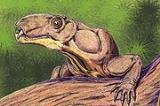
Phthinosuchus
Encyclopedia
Phthinosuchus was a therapsid (mammal-like reptile) that lived in the Late Permian
of Russia
. Phthinosuchus is the sole member of its family and suborder, although Phthinosaurus may be a relative. Phthinosuchus is one of the most primitive therapsids, and its ancestors must have branched off early from the main therapsid line.
Phthinosuchus looked much like the Sphenacodontids
, such as Dimetrodon
and Sphenacodon
. Its temporal fenestrae were larger than those of the Sphenacodontids. Like the other early therapsids
, it was probably scaly skinned, sprawling, and carnivorous.
Permian
The PermianThe term "Permian" was introduced into geology in 1841 by Sir Sir R. I. Murchison, president of the Geological Society of London, who identified typical strata in extensive Russian explorations undertaken with Edouard de Verneuil; Murchison asserted in 1841 that he named his "Permian...
of Russia
Russia
Russia or , officially known as both Russia and the Russian Federation , is a country in northern Eurasia. It is a federal semi-presidential republic, comprising 83 federal subjects...
. Phthinosuchus is the sole member of its family and suborder, although Phthinosaurus may be a relative. Phthinosuchus is one of the most primitive therapsids, and its ancestors must have branched off early from the main therapsid line.
Phthinosuchus looked much like the Sphenacodontids
Sphenacodontidae
Sphenacodontidae is a family of small to large, advanced, carnivorous, Late Pennsylvanian to middle Permian pelycosaurs. Primitive forms were generally small in size , but during the later part of the early Permian these animals grew progressively larger , to become the top predators of their...
, such as Dimetrodon
Dimetrodon
Dimetrodon was a predatory synapsid genus that flourished during the Permian period, living between 280–265 million years ago ....
and Sphenacodon
Sphenacodon
Sphenacodon was a pelycosaur that was about in length. Sphenacodon belongs to the family Sphenacodontidae, a lineage that was related to the therapsids...
. Its temporal fenestrae were larger than those of the Sphenacodontids. Like the other early therapsids
Biarmosuchia
Biarmosuchia, also known as Eotitanosuchia and Phthinosuchia, is an assemblage of primitive Permian therapsids that represent either a paraphyletic stem group or a very early off-shoot of the main therapsid tree....
, it was probably scaly skinned, sprawling, and carnivorous.

